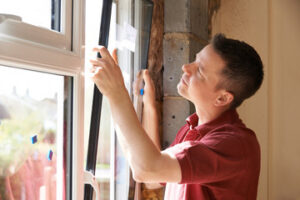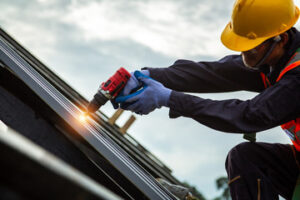Window replacement can be a time-consuming project, but it’s important to get accurate measurements so the new windows fit. Improper installation can lead to water leaks, mold and pests. Reach out Maryland Window Replacement for comprehensive assistance.

Use a tape measure to check horizontally along the bottom, middle and top of the window frame. Write down the smallest measurement and subtract 1/8-inch.
Windows are your home’s first line of defense against harsh weather and outside elements, so they take a beating throughout the year. But a window is also prone to damage from the inside, especially if your family accidentally tosses a Wiffle ball through it or one of your kids shatters the glass with a baseball. When this happens, you’ll want to replace your damaged window with a new pane as quickly as possible for several reasons.
Cracked windows look unattractive and can decrease the value of your home. Plus, they can pose a shatter hazard that could injure you or your family.
Even small cracks in a window can worsen over time. These cracks can allow air to enter or escape your home, lowering energy efficiency and putting additional strain on your heating and cooling system.
You can prevent cracks from forming in the first place by using a caulking gun to seal any additional gaps around the frame and the window panel. You can also use a putty to fill any cracks in the frame and pane that occur naturally over time.
If you notice a crack developing in your window, it’s important to contact a professional immediately for a replacement. A professional will inspect the damage and determine the cause of the crack, which may help you qualify for a warranty claim from the manufacturer or supplier.
The best way to replace your cracked window is with a double-pane window that is energy efficient. Double-pane windows rely on an air-tight seal to function properly, so they must be replaced as soon as either of the window panes become cracked.
You can prevent the loss of energy efficiency by contacting a professional window repair company to replace your broken window. They will remove the glazing beads and the old window unit, then carefully install the new window using adjustment shims to ensure that both the frame and glass are level. They will then apply a high-quality window sealant to ensure that the new pane is fully secure and watertight. This will help reduce drafts, lower your energy bills, and protect your home from the elements for years to come.
Water Damage
Water damage around windows is a common problem that can lead to costly repairs. It’s important to address water damage promptly to prevent mold and rot and to protect the integrity of your home. The first step in repairing window water damage is to identify the source of the problem. Then, you can take steps to repair the damage and stop further deterioration.
Several factors can cause window water damage, including clogged drainage holes, leaky seals, and improper flashing. A thorough inspection of the window frame, sash, and glazing will help you identify the problem. You can also check the window’s drainage channels and weep holes to ensure they are clear of debris and functioning properly. In addition, you should check the flashing, which is a barrier that helps prevent water leaks. If you find a gap or crack, you can apply a bead of waterproof caulk to seal the area and prevent future leaks.
Window sills and frames are usually made of wood, which can become damaged due to exposure to moisture or structural issues such as rotting. If the wood is rotting, it may be time to replace the window sill. If the sill is simply dingy, you can sand down the damaged area and apply a wood epoxy primer to smooth the surface. This will restore the integrity of the wood and improve its appearance.
If the damage is extensive, you will need to replace the entire window frame. Start by removing the old frame and cleaning the area. Once the wood is clean, you can sand down the area to prepare it for new paint or stain. Use a hand or orbital sander to remove any remaining loose or rotting areas of the frame. Once the wood is smooth, you can apply a coat of primer and allow it to dry completely before applying any desired color.
Replacing a window sill or frame is an easy DIY project that can help protect your home from moisture damage and enhance its curb appeal. However, before you begin working on any projects, it’s important to shut off power in the area and wear protective gear like gloves, safety goggles, and a mask. You should also gather your tools and supplies, such as a wet/dry vacuum, a dehumidifier (rent a commercial-grade dehumidifier for best results), sandpaper in various grits, a caulking gun, waterproof tape, and some cleaning solutions that are designed to kill mold.
Rotted Frames
Wood rot is a common problem for window frames, especially in older homes or those located in damp climates. Often caused by prolonged exposure to moisture, this issue can be difficult to detect, but a few simple precautions can help homeowners determine when it’s time for repair or replacement.
If a rotted frame is left untreated, it can compromise the structural integrity of your home’s windows and lead to mold growth and energy inefficiency. The best way to determine if your frames are rotting is through visual inspection or, if necessary, probing with a screwdriver. Soft and crumbling wood indicates rot, which should be treated immediately.
Window frame repairs aren’t always easy, but they can be much cheaper and more effective than replacements. Before starting the repair process, it’s important to thoroughly assess the damage and determine if it will be possible to save the damaged pieces of wood. After the removal of the rotted areas, it’s essential to apply a wood hardener to the remaining weakened areas. This will fortify the frame against future deterioration and protect the surrounding areas from moisture infiltration.
The final step of the repair process involves securing the new window frame and glass to the remaining intact parts of the wood, then caulking all edges to seal out drafts and water. If any holes are discovered, they can be filled with wood putty to create a smooth and polished finish. Lastly, the entire window frame and glass are painted or stained to match the existing aesthetic of the window’s surroundings.
Repairing a rotten window frame instead of replacing it is more cost-effective and environmentally friendly. Additionally, repairing your windows can be a great opportunity to upgrade to more energy-efficient options. With proper maintenance, a repaired window can last for years to come. Regular painting, caulking and routine inspections can also prolong the life of a window and reduce future repair needs. However, if the damage is too severe to repair, replacing your window may be the most prudent choice. In this case, it’s best to have a professional handle the window replacement to ensure a quality and long-lasting installation.
Muntins or Mullions
Although often mistaken for each other, a muntin and mullion are two different elements that play unique roles in window or door customization. These separating bars help create an illusion of multiple panes to make windows look larger and add visual interest. They can also enhance security by making it harder for intruders to break into your home. While many companies don’t put much emphasis on the difference between these two terms, understanding the distinctions can help you choose the right option for your window replacement project.
Mullions are vertical dividers between the glass panes in a window or door. They’re commonly seen on Victorian-style homes, Craftsman-style houses, classic/historical homes, and modern farmhouses. Although they’re now primarily used for aesthetic purposes, they were initially developed to provide structural support. Back then, manufacturing large sheets of plate glass was impractical or expensive, so builders would construct them by holding smaller panes of glass together with supportive mullions.
Aside from enhancing a home’s historical appeal, a mullion or muntin can make your windows look taller. This is because they add vertical lines that draw attention upward and make rooms or your entire house appear bigger than they are. Additionally, they can be combined with other elements to increase natural light and views while providing more privacy in your home.
If your new windows don’t come with a set of muntins, you can purchase them separately from a window or door company. Then, you’ll need to bond them into place on the frames using epoxy. For the best results, mix the epoxy’s resin and hardener together before applying it to your muntins. It’s important to follow the instructions carefully to ensure that you get a strong and secure adhesive that holds up to weather and time.
You can also choose to have your professional installers add muntins to your existing windows or doors if they weren’t built with these components. They can use a retaining clip to hold the muntins in place and ensure they line up perfectly with the frame edges. They can also help you decide on a design for the muntins to enhance your aesthetic preferences or architectural style.








